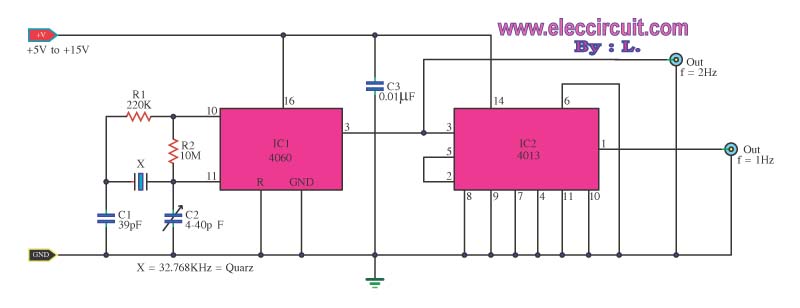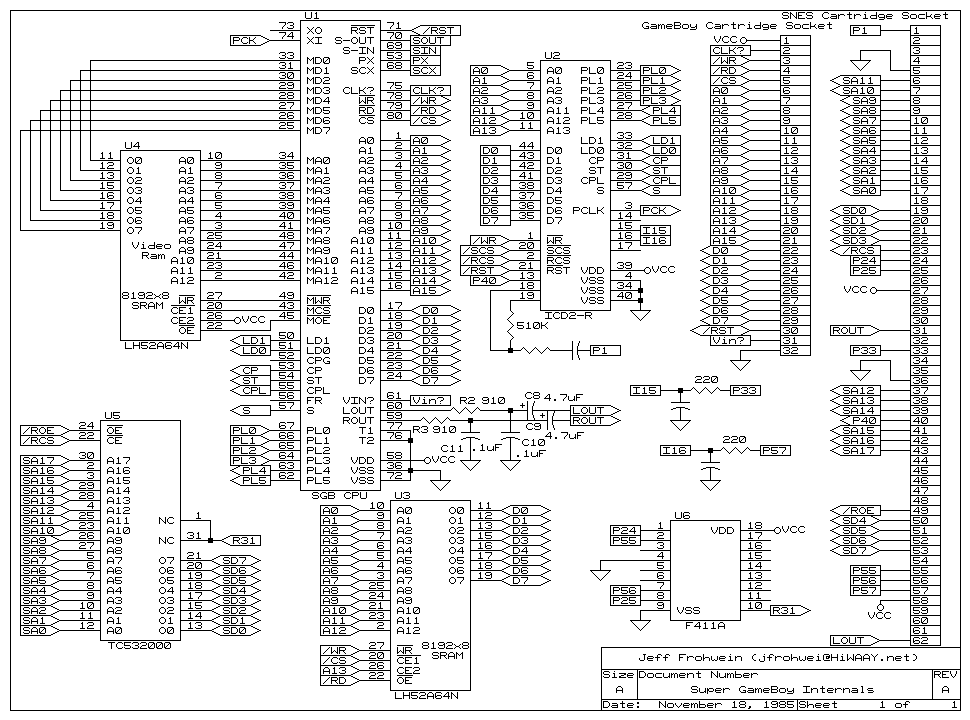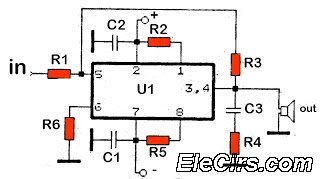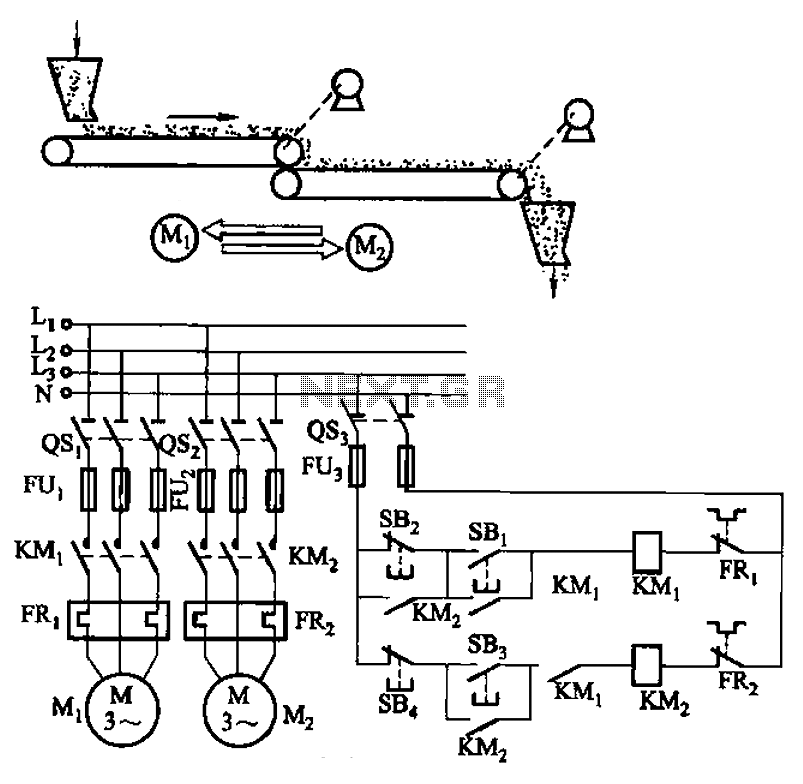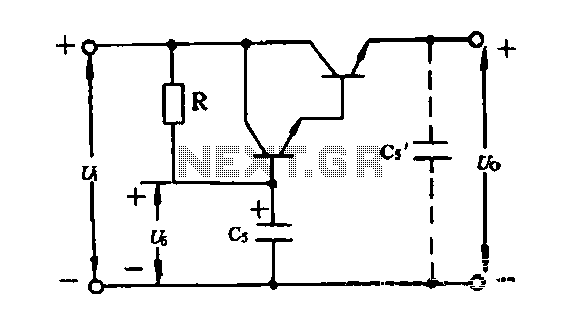
Electronic Lock
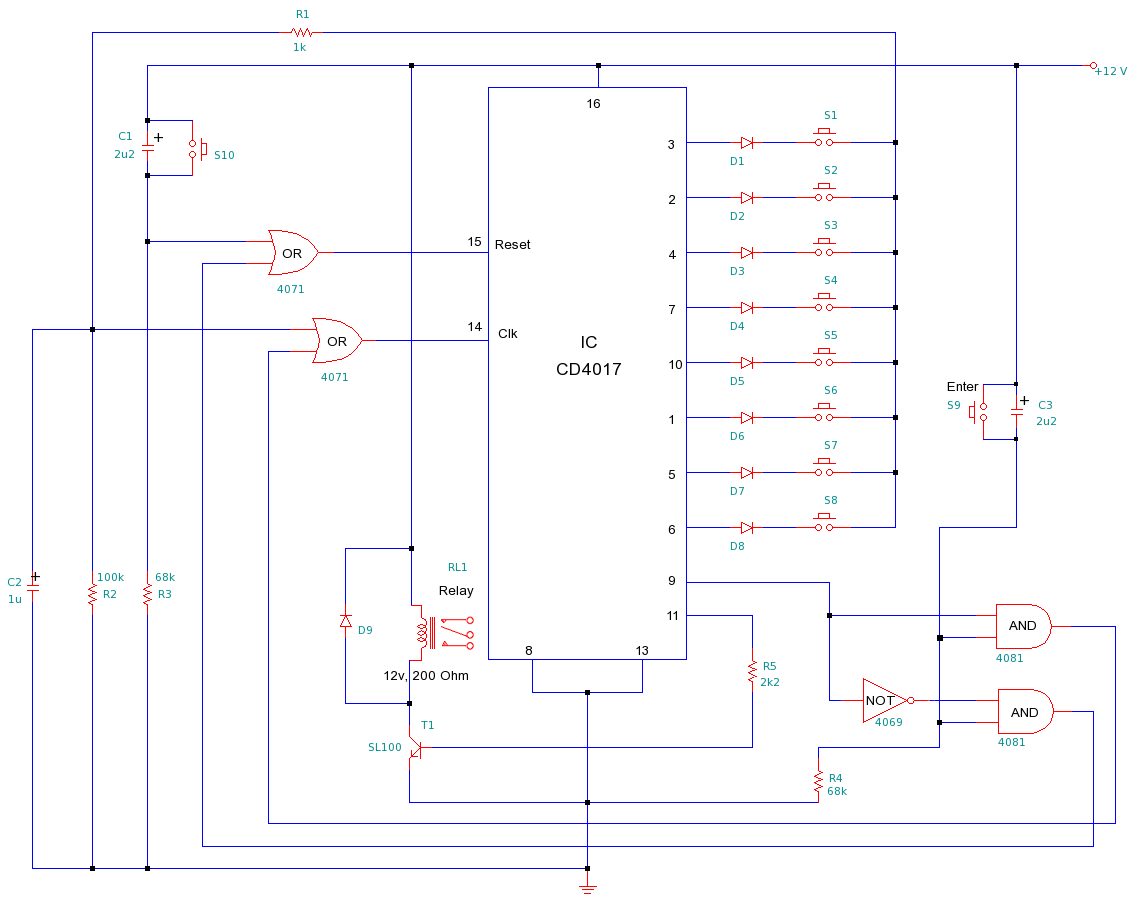
This is a simple yet efficient electronic lock designed to protect electronic systems from unauthorized access. To gain entry, the user must input an 8-digit passcode followed by the "Enter" button. If the correct passcode is entered, the relay is activated, granting access to the system controlled by the relay. Conversely, if the passcode is incorrect, pressing the "Enter" button will reset the circuit without activating the relay. The core component of the circuit is the IC1 (4017) decade counter. Upon powering up, the counter begins at zero, with only pin-3 of IC1 being high. Pressing switch S1 momentarily provides a clock pulse to the counter, incrementing the count and shifting the high state from one pin to the next (counting pulses). For instance, after power-on, pressing S1 will shift the high state from pin-3 to pin-2. Subsequent presses of S2 will move the high state from pin-2 to pin-4, and so forth. By sequentially pressing S1 to S8, the high state moves from pin-3 to 2, 4, 7, 10, 1, 5, 6, and finally to pin-9. Only when pin-9 is high will pressing the "Enter" button activate the relay and unlock the system. Any incorrect entry will reset the sequence. The circuit can also be intentionally reset by pressing the "Reset" button (S10). Switches S1 to S8 can be assigned random display numbers, and their random arrangement can enhance security by making it difficult to guess the passcode (potentially arranged in a 3x3 switch matrix). To increase code complexity, one or more parallel connections of switch S10 can be placed among S1 to S8, ensuring that random presses continuously reset the circuit and prevent access. Additional components IC2 (CD4071), IC3 (CD4081), and IC4 (CD4069) are utilized to implement logic that resets the circuit upon entering an incorrect passcode. While the circuit can be simplified by reducing specific logic components, this may compromise the lock's security.
The electronic lock circuit operates on a straightforward principle of counting and logic, utilizing a decade counter to track the sequence of correct button presses. The IC1 (4017) decade counter serves as the primary counting mechanism, where each button press generates a clock pulse that increments the counter. The design allows for a maximum of 8 sequential presses, corresponding to the digits of the passcode. The circuit's resilience against incorrect entries is further enhanced by the logic gates provided by IC2, IC3, and IC4, which ensure that any erroneous input triggers a reset, thereby safeguarding the system from unauthorized access attempts.
In terms of physical implementation, the switches S1 to S8 can be arranged in a user-friendly layout, potentially as a keypad, to facilitate ease of use. The randomization of the switch positions adds an additional layer of complexity, making it more challenging for potential intruders to guess the correct sequence. The inclusion of the reset button (S10) allows users to quickly clear the current input sequence, which is particularly useful in scenarios where an incorrect passcode is entered or if the user wishes to start over.
Overall, this electronic lock circuit exemplifies an effective balance between simplicity and security, making it suitable for various applications requiring controlled access to electronic systems. The ability to rewire the switches for altering the passcode further enhances the lock's adaptability, allowing it to meet changing security needs without significant redesign.This is a simple but efficient Electronic lock. This lock can be used to protect any electronic systems from unauthorized usage. To get access the uses needs to know 8 digit pass-code or password. When the user enters correct 8 digit password followed by "Enter" button, it activates the relay allowing access to the system controlled by relay. If t he 8 digit pass-code is incorrect, after pressing "Enter" button, the circuits reset`s itself without turning the relay on. Heart of the circuit is IC1 (4017) decade counter. At power up, the counter will be at zero count and only pin-3 of IC1 will be high. If switch S1 is pressed momentarily it will provide a clock pulse for the counter which will increment the count and move high value from one pin to another (counting pulses) < /br> For example after power-on, only pressing S1 will switch high value from pin-3 to pin-2.
After that only pressing S2 will move high value from pin-2 to pin4. Hence by pressing S1 to S8 sequentially, the high level on the pins shifts from pin-3 to 2 -> 4 -> 7 -> 10 -> 1 -> 5 -> 6-> and finally to pin-9. Only and only when ping 9 is high, pressing the "Enter" button will activate the relay and the clock will get opened.
Any wrong-entry will reset the sequence. This circuit can be intentionally reseted by pressing the "Reset" button (S10). Switches S1 to S8 can be given random display numbers, and their random placement will make it difficult to guess the pass-code ( may be placing them as 3x3 switch matrix). One or more parallel connection switches of S10 can be placed in between S1 to S8 to increase the complexity of the code, so that any random pressing will repeatedly keep reseting the circuit and not allowing any access.
IC2 (CD4071), IC3 (CD4081) and IC4 (CD4069) are used to provide logic so that the circuit gets reset if incorrect pass-code is entered. This circuit can be simplified by reducing this specific logic, which also means compromising the strength of the lock.
* NOTE : To alter the pass-code of this combination lock, you simply re-wire the switches. All the material on this website is copyright property of Material on this site is for personal use only and can not be used for any commercial activity without written permission of Use the information provided within this website at your own risk. Information within this website is provided as-is without warranty or guarantee of any kind. Please read Copyright and Disclaimer notice carefully. 🔗 External reference
The electronic lock circuit operates on a straightforward principle of counting and logic, utilizing a decade counter to track the sequence of correct button presses. The IC1 (4017) decade counter serves as the primary counting mechanism, where each button press generates a clock pulse that increments the counter. The design allows for a maximum of 8 sequential presses, corresponding to the digits of the passcode. The circuit's resilience against incorrect entries is further enhanced by the logic gates provided by IC2, IC3, and IC4, which ensure that any erroneous input triggers a reset, thereby safeguarding the system from unauthorized access attempts.
In terms of physical implementation, the switches S1 to S8 can be arranged in a user-friendly layout, potentially as a keypad, to facilitate ease of use. The randomization of the switch positions adds an additional layer of complexity, making it more challenging for potential intruders to guess the correct sequence. The inclusion of the reset button (S10) allows users to quickly clear the current input sequence, which is particularly useful in scenarios where an incorrect passcode is entered or if the user wishes to start over.
Overall, this electronic lock circuit exemplifies an effective balance between simplicity and security, making it suitable for various applications requiring controlled access to electronic systems. The ability to rewire the switches for altering the passcode further enhances the lock's adaptability, allowing it to meet changing security needs without significant redesign.This is a simple but efficient Electronic lock. This lock can be used to protect any electronic systems from unauthorized usage. To get access the uses needs to know 8 digit pass-code or password. When the user enters correct 8 digit password followed by "Enter" button, it activates the relay allowing access to the system controlled by relay. If t he 8 digit pass-code is incorrect, after pressing "Enter" button, the circuits reset`s itself without turning the relay on. Heart of the circuit is IC1 (4017) decade counter. At power up, the counter will be at zero count and only pin-3 of IC1 will be high. If switch S1 is pressed momentarily it will provide a clock pulse for the counter which will increment the count and move high value from one pin to another (counting pulses) < /br> For example after power-on, only pressing S1 will switch high value from pin-3 to pin-2.
After that only pressing S2 will move high value from pin-2 to pin4. Hence by pressing S1 to S8 sequentially, the high level on the pins shifts from pin-3 to 2 -> 4 -> 7 -> 10 -> 1 -> 5 -> 6-> and finally to pin-9. Only and only when ping 9 is high, pressing the "Enter" button will activate the relay and the clock will get opened.
Any wrong-entry will reset the sequence. This circuit can be intentionally reseted by pressing the "Reset" button (S10). Switches S1 to S8 can be given random display numbers, and their random placement will make it difficult to guess the pass-code ( may be placing them as 3x3 switch matrix). One or more parallel connection switches of S10 can be placed in between S1 to S8 to increase the complexity of the code, so that any random pressing will repeatedly keep reseting the circuit and not allowing any access.
IC2 (CD4071), IC3 (CD4081) and IC4 (CD4069) are used to provide logic so that the circuit gets reset if incorrect pass-code is entered. This circuit can be simplified by reducing this specific logic, which also means compromising the strength of the lock.
* NOTE : To alter the pass-code of this combination lock, you simply re-wire the switches. All the material on this website is copyright property of Material on this site is for personal use only and can not be used for any commercial activity without written permission of Use the information provided within this website at your own risk. Information within this website is provided as-is without warranty or guarantee of any kind. Please read Copyright and Disclaimer notice carefully. 🔗 External reference
